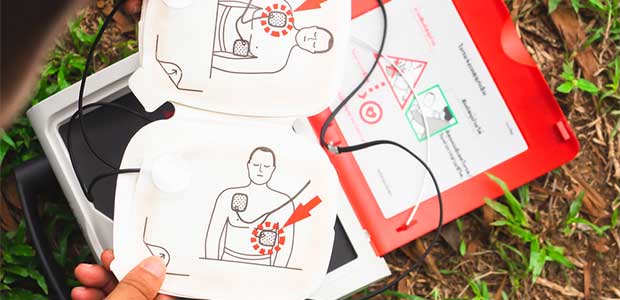
Page 3 of 3
When Minutes Matter: CPR and AEDs at Work
Second Nature
The importance of CPR and AEDs is not lost to the employees of Shelby Electric Cooperative in Illinois. On May 8, 2018, forestry foreman Kevin Carlen lost consciousness while hanging mid-air as part of a pole top rescue training.
“I took two steps and then everything went black,” recalled Carlen.
His fellow linemen sprang into action, belaying him down the pole, calling 911, beginning CPR and getting the AED.
The AED restarted Carlen’s heart to a normal rhythm.
“I’ve seen how people are doing the training year after year after year—it was second nature to us when it did occur,” said Thad France, manager of line-worker development for Shelby Electric Cooperative. “As I started yelling instructions, everybody was already doing everything I was yelling.”
It took the ambulance three and a half minutes to arrive, during which the years of training and access to the right equipment kicked in. Being prepared made the difference in the most important three and a half minutes of their stricken colleague’s life.
Luke Brown, an apprentice lineman at Shelby Electric, summed it up: “If you can just save somebody, why wouldn’t you?”
Publisher's Note: The following appeared alongside this article as a sidebar in the OH&S Magazine September 2022 issue.
How It Works: The Red Cross Cardiac Arrest Chain of Survival
A worker suddenly collapses on the job. Someone recognizes that the unresponsive person is suffering cardiac arrest.
Step 1. That person activates the emergency response system, either by calling 911 or asking someone else to do so. Someone is sent to get the AED.
Step 2. Cardiopulmonary resuscitation (CPR) begins, preferably by a trained employee using chest compressions and ventilations. Compressions manually pump oxygenated blood to the brain and other organs while “rescue breaths” provide additional oxygen to the blood.
Step 3. A heart in ventricular fibrillation may only be restored to normal by an electric shock as early as possible. AEDs are designed to be simple. Once the pads are positioned on the victim’s chest, the AED will analyze the heart rhythm and advise the responder to deliver a shock if needed using voice prompts. If a heartbeat is present, the AED will not allow a shock to be delivered.
Step 4. The emergency medical services (EMS) team arrives. CPR continues until the paramedics are ready to take over. At that point, the immediate responders can step aside while EMS professionals begin advanced care.
Step 5. The patient is transported to the hospital, where a team of medical professionals goes to work.
Step 6. The recovery step begins as soon as the patient wakes up from the life-altering event. The Red Cross added this new step in 2021 to ensure that progress continues after the hospital stay concludes. Says Mark Whelchel, director of Healthcare and Prehospital Education for the Red Cross, “We may have saved their lives, but there is a long-term critical care need beyond the hospital because these patients’ hearts are severely damaged.”
This article originally appeared in the September 1, 2022 issue of Occupational Health & Safety.
About the Author
Dom Tolli is senior vice president for product management and platform development at the American Red Cross. Visit www.redcross.org/training for more information about Red Cross workplace safety training and starting an AED program.